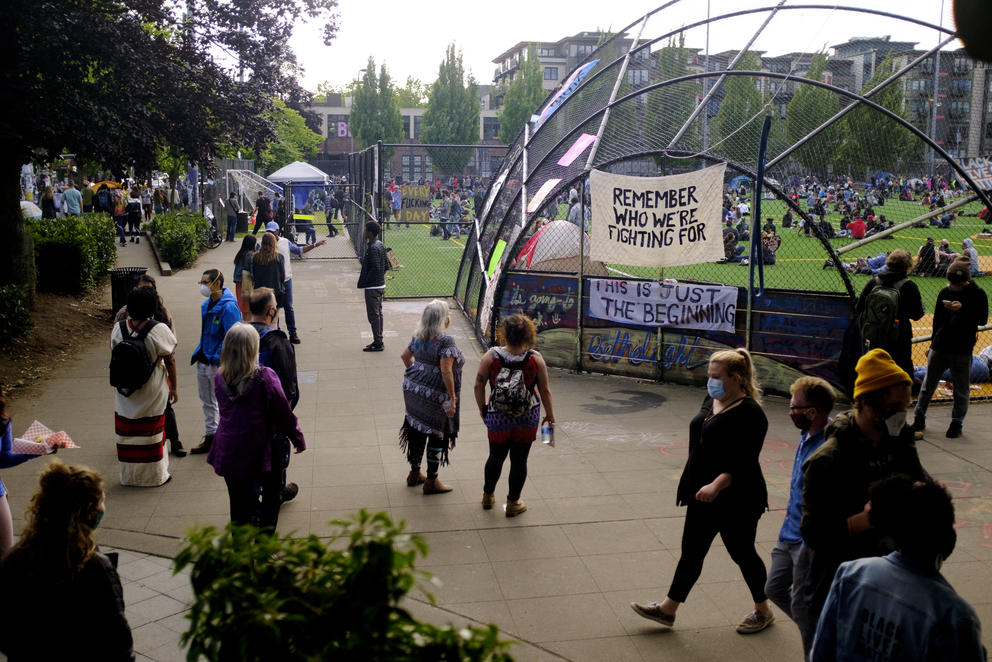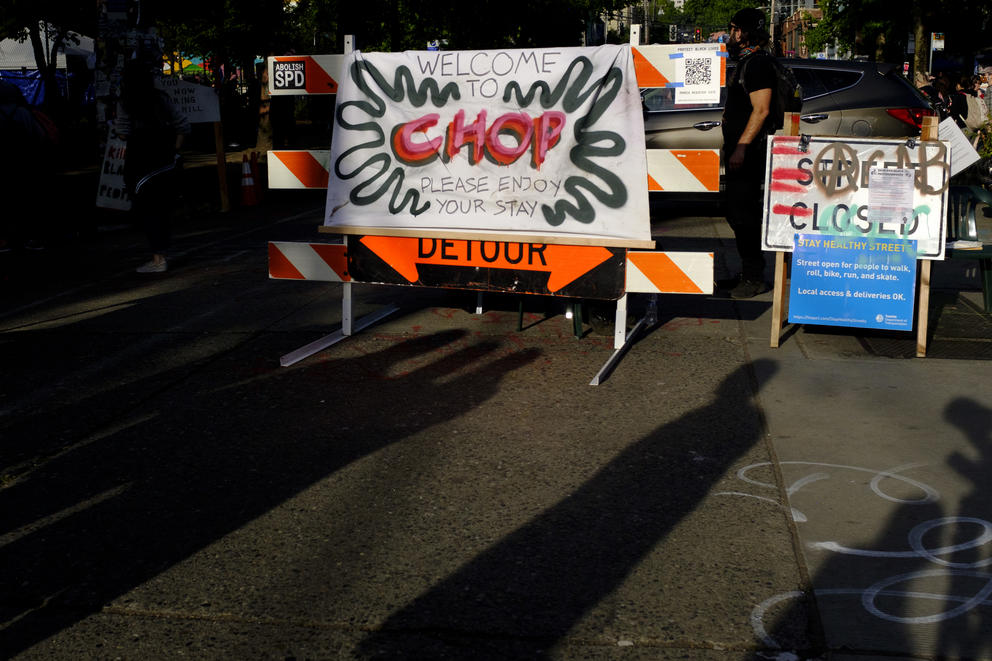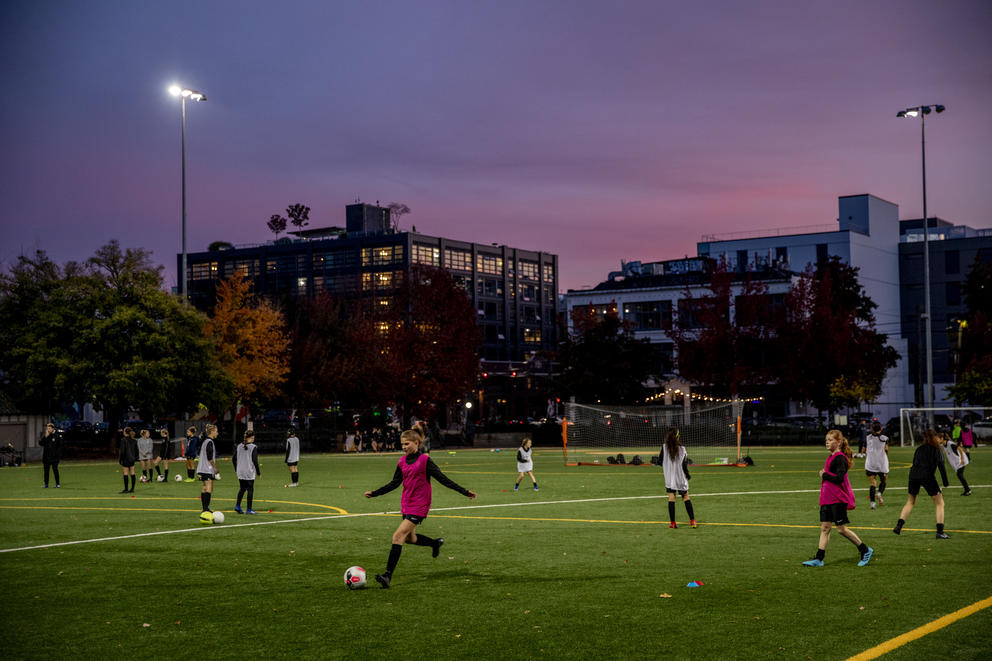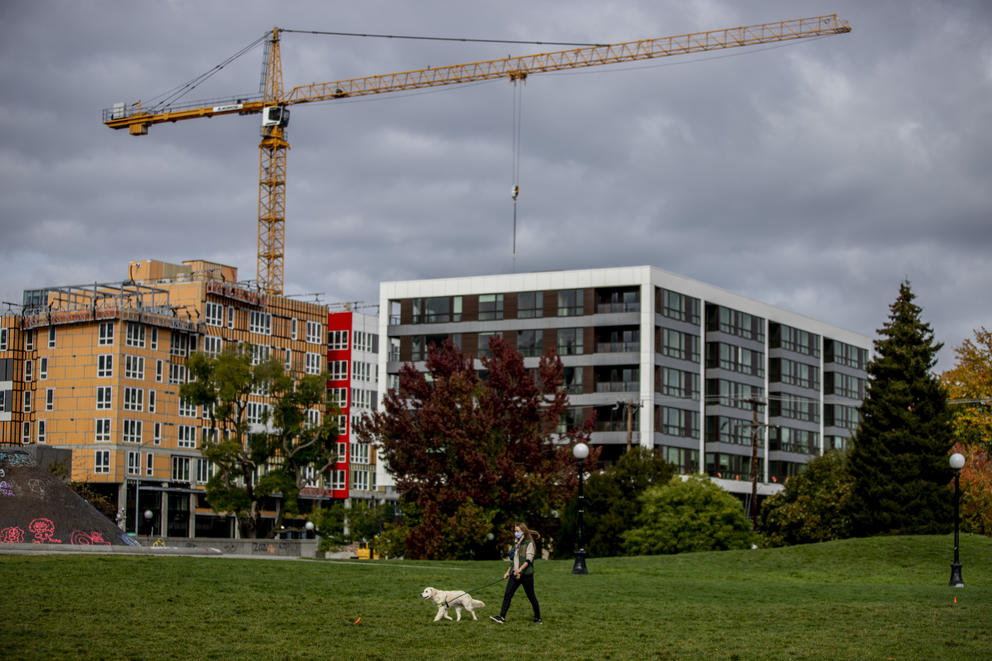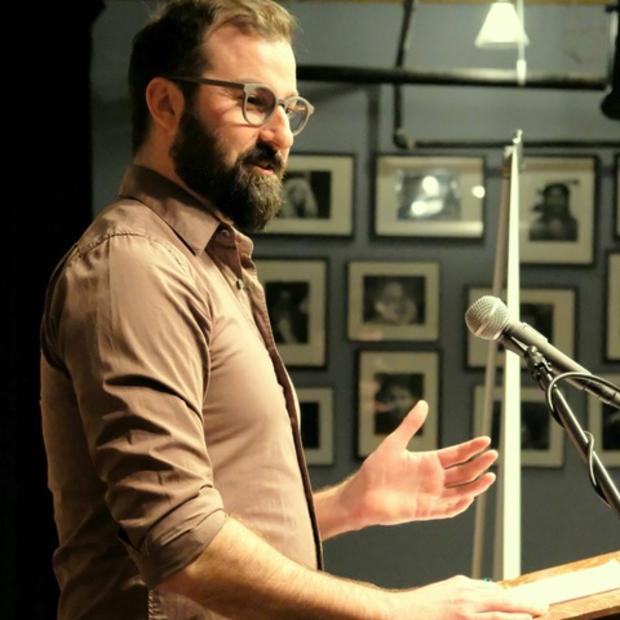One memorable feature of this summer’s Capitol Hill Autonomous Zone (CHAZ) — later known as the Capitol Hill Organizing Protest (CHOP) — was the proliferation of spontaneous protest art, like the giant power fist raised on Bobby Morris Field. President Donald Trump would later turn that creativity and political dissent against the people of Seattle in a campaign ad that painted efforts to defund the Seattle Police Department as the work of anarchists, wreckers and other un-Americans. Given Trump's well-documented habit of taking his cues from Fox News, one suspects that Mike Solan, Seattle Police Officers Guild president and frequent Fox News guest, helped color the image of a lawless Seattle that Trump wanted so badly.
But you don’t need to follow national or international news to know that Cal Anderson lingers in everyone’s mind. “Is the whole city on fire?” My students, friends and family have all reported calls from relatives in Arizona, Florida, New Jersey and beyond. “Are you safe?” Even on the Olympic Peninsula, Twitter and Facebook rumors sparked such panic that citizens leapt at antifa shadows, resulting in one family trapped on a logging road behind downed trees. “I heard it’s a free-for-all!”
At only 1 1/2 blocks wide by 3 blocks long, Cal Anderson occupies a giant place in our political imagination relative to its size. The unpredictable rise and fall of the CHOP — its roots in BLM protest, its growth in response to SPD brutality and their eventual abandonment of the East Precinct — kept quarantined news consumers face-to-screen. Across the country, it was a total-package story tailor-made for lockdown: new politics, strange art, righteous activism, violent crime and the endless commentary culture around it. But how will the CHOP fit into the history and future of Cal Anderson Park?
Seattle saw two political awakenings at Cal Anderson this summer. As BLM and other leftists organizations coalesced into a broader movement against unfair policing, a real physical distance erupted between local events and national reporting. It was a raw experience felt physically by those who attended the CHOP. This complicated blend of hope and despair, and the busy organizing that went into managing each, ended after shots rang out in the night, two were killed, and the SPD swept the protesters out.
The feeling of Cal Anderson is subdued now. The park isn’t technically open, but it remains busy, dirty and diminished. I walk through daily and wonder what happened to the place.
The atmosphere of history
Enormous historical and political forces have always shaped the place we call Cal Anderson Park. Long before it was a park, before the city of Seattle was founded in 1851, the place served the Duwamish, the People of the Inside, for thousands of years.
In 1856, the USS Decatur fired uphill from Elliott Bay on Native Americans on Capitol Hill; a U.S. Navy map from the time describes Seattle as surrounded by “Hills and Woods Thronged with Indians.” Although courts eventually discharged 20 Native Americans for engaging in “legitimate warfare,” after this original Battle of Seattle Gov. Isaac Stevens and Snoqualmie Chief Patkanim set bounties for the heads of enemy tribal leaders at $80. Many Native Americans still visit Cal Anderson, including Nuu-chah-nulth artist Rick Williams, whose brother, John T. Williams, was killed by ex-SPD Officer Ian Birk. Rick set up a tent with a carving station at the CHOP, a somber presence around which swirled a fluid blend of anger and joy, resentment and release.
Fifty years after the place was taken by conquest, the terraforming that shaped early Seattle transformed the area into Lincoln Park, beginning in 1904.
When I was an undergrad at the University of Washington in the late ’90s, you could grab a burger at Dick’s on Broadway and walk a block over to the Lincoln Reservoir, mostly a gravel track around a wide pool of water with a burbling fountain in it, all contained within a tall, rusted fence. This pool of water made the bulk of Lincoln Park a nonplace: As a source of the city's drinking water, you couldn’t access it, and any view was through gritty chain link and barbed wire. Although Lincoln Park had been designed in 1904 by the same Olmsted Brothers who designed Central Park in New York City, it felt less like a forest grove and more like a military base.
On the south side of the reservoir, the separate Bobby Morris Playfield hosted games of baseball, soccer, basketball and tennis. In the constant evolution of the park, tennis players would eventually cede one of these courts to skateboarders.
Between these two separate parks sat the cramped, filthy and gloriously graffitied public restrooms, with all the public appeal of a haunted outhouse. But if you listened carefully, you might hear the shovel work of Groundswell Off Broadway.
Under the enormous initiative and effort of Kay Rood, the small group led the transformation of Cal Anderson Park from a neglected and uninviting place to a bright and busy recreational spot over a decade, fueled by an estimated $1.12 million in grants and donations. The city recognized the park’s decay and the need to lid the drinking water, but it took the efforts of concerned locals to cover the reservoir, giving the park an open field and its volcano-shaped fountain.
The lidding produced new land, something always in short supply in Seattle. Rood writes, “The biggest gratification is that the variety of uses is as wide as the variety of people ... a new balance of enjoyment and respect for one another, and for this place, has been achieved.” Groundswell’s massive effort resulted in a new design for the combined city parks, now named for state Sen. Cal Anderson, who pushed for civil rights and low-income housing, and was Washington state’s first openly gay legislator.
From Cal Anderson to CHAZ/CHOP
As one piece of Seattle’s system of city parks, Cal Anderson is uniquely centered among high-density housing and businesses in close proximity to public transportation nodes for light rail, streetcar and bus. While the fountain is peaceful (when it’s working), the overall vibe of the park is normally one of busy recreation. The playfields still dominate the south end of the park, and the north end is often occupied by picnickers and dog owners who use the grassy area for fetch.
After SPD stopped a BLM march moving uphill from downtown on June 1, the open recreation area was the obvious choice for staging a continued, stationary protest off-street and in public space. Organizing spilled into the street as well, but the walls came up after June 7, when Nikolas Fernandez appeared to drive his car at the crowd of protestors, Dan Gregory attempted to stop him and was shot for the effort. Senior Deputy Prosecutor Karissa Taylor noted, “Protesters yelled at [Nikolas] to stop, and even put a metal barrier in his path.” This first metal barrier grew to surround the area as protesters reasonably feared they’d be the victims of vehicular assault. Cars would eventually strike and injure at least 104 other BLM protesters across the country.
A day later, on June 8, SPD abandoned the East Precinct — to the confusion of all, including members of SPD themselves — and the protest settled in and expanded. Because this action came after a week of clashes with protesters where the use of tear gas, flash-bangs, pepper spray and fists resulted in 12,000 complaints against the department, the mood at Cal Anderson was one of victory. The police who stopped protester Aubreanna Inda’s heart with a flash-bang shot to the chest had pulled up stakes and quit the precinct. Why wouldn’t everyone in the CHAZ — fellow protesters, watchers, the volunteer medics who brought Inda back from cardiac arrest three times — celebrate?
With the police presence gone, the CHAZ blossomed into CHOP. A Decolonization Conversation Café, booths for state initiatives and political parties, mutual aid tents of food and water, medic tents and two free libraries of Black and Indigenous writers and anti-racist literature all took root.
Artists painted an enormous BLACK LIVES MATTER on Pine Street from 11th to 12th Avenue. Protester Marcus Henderson started a community garden that quickly grew through donations, while Mary Hall-Williams and Reagan Jackson organized a day of Black healing called a Black Out. It was a free-for-all in the best sense of the term, what writer Ashley Garcia dubbed “alternative institution building,” a hallowed American tradition. On June 10, Mayor Jenny Durkan captured a bit of this mood when referring to the protest in Cal Anderson Park as Seattle’s “summer of love.”
Under the surface joy, the fevered work of organizing for criminal justice reform continued. Like Capitol Hill’s Q-Safety Patrol in the ’90s, protesters formed community patrols against attacks, and for good reason: In the U.S., white supremacists’ attacks on protesters accounted for 50% of domestic terrorism in 2020.
At night, the mood in Cal Anderson turned to one of caution and worry. Twitter and Facebook activity threatened an armed invasion of Proud Boys, and some, like Tusitala “Tiny” Toese, arrived to physically assault protesters.
Nearly two weeks after the CHOP’s founding, the mood grew darker. On June 20 and 21, two people were shot near the CHOP: 19-year-old Lorenzo Anderson, and a 17-year old who declined to speak with SPD. At the time of the first shooting, ex-Chief Carmen Best declared protesters stopped SPD and the Seattle Fire Department from reaching Lorenzo before he died. SPD spokesperson said a “violent crowd ... prevented officers safe access to the victims.” In July, KUOW would reveal that Chief Best’s framing of obstinate and violent protesters was a lie.
Another hoax perpetrated by the SPD was the claim that CHOP protesters extorted nearby businesses, what Best later walked back by saying, “That has not happened affirmatively.” This pipeline of lies flowed to national news organizations, such as Fox, which illustrated Seattle protests with photos of the burning Minneapolis Police Department.
Concerned texts pinged many Seattleites' phones: “Is the whole city on fire?”
It wasn’t, but the mood soured further when a man in his 30s was shot on June 23. On June 25, a group called Black Collective Voice held a press conference to reject the “false narrative that protesting police brutality caused the crime that has always been prevalent at and around Cal Anderson Park.”
Still, on June 29, 16-year-old Antonio Mays Jr., and his 14-year-old companion, were shot amid chaos and confusion in the CHOP. Antonio would die from his wounds. No arrests have been made so far in the case.
With anti-protest sentiment rising alongside bad news, Durkan said, “It’s time for people to go home.” But I visited Cal Anderson the night after the last shooting to discover that many of the protesters had already left. I watched two optimistic protesters who tried and failed to get a game of wiffle ball going.
Durkan ordered the clearing of Cal Anderson on July 1, and SPD swept out the CHOP and closed the park. During my press escort through the park later on the day of the sweep, one officer enjoyed a celebratory cigar. But those claiming that the CHOP caused violence must also reckon with the fact that murders occurred in the park before and after its brief life. As the Capitol Hill Seattle Blog notes, digging into SPD’s statistics reveals that in 2020 violent crime is down in Seattle generally and on Capitol Hill specifically.
Marcus Henderson works in the community garden on Thurs. June 11, 2020, at the Capitol Hill Autonomous Zone (CHAZ) in Seattle. The area surrounding Cal Anderson Park in the Capitol Hill neighborhood had been claimed by protesters and included art instillations, a co-op, medical tent and library. (Sarah Hoffman/Crosscut)
What remains
A number of alternative institutions blossomed from the BLM protests and the CHOP. Early in the coverage of events, activists noticed the slant of national news, writing, “The occupiers at CHAZ roundly reject the false and harmful narrative peddled by all sides of the mass media.” Along with Black Collective Voice, Omari Salisbury’s tireless eyewitness reporting on the protests in and around Cal Anderson Park solidified the excellent Converge Media as an integral contributor to local news coverage. Marcus Green’s South Seattle Emerald produced some of the finest on-the-ground reporting on the BLM movement in Seattle all year. As for the protests, there are still as many as three or four marches a day in Seattle. The sounds of protests reached the ears of the Seattle Parks and Recreation, which has held community meetings since September to discuss the future of the park.
I attended one on Oct. 7 in which SPR presented its plans for maintenance and improvements, as well as the results of a public survey on desired changes to the park. Most of the proposed design changes came directly from ideas that originated within CHOP, including a conversation circle based on the Decolonization Conversation Café and a community garden based on Marcus Henderson’s spontaneous contribution. The final location of these park design features is undecided, but Henderson's spontaneous project has matured into Black Star Farmers, which collaborates with SPR and groups like Plant-Based Food Share and Hip Hop is Green to supply food sovereignty programs.
Reports of Cal Anderson Park’s death are greatly exaggerated, and I’d gamble that the end of the pandemic will breathe new life into it.
Although involved in talks with SPD, Seattle Parks and Recreation had no interest in declaring that Cal Anderson would be patrolled more heavily. Emphasis instead was placed on increasing activities and programming, repairing vandalism and better upkeep. Better lighting would give the park a safer feel. There is talk of hiring a park steward to direct visitors to food and housing resources, if needed.
These are all excellent solutions to combat the neglect and abuse of the park. But on my last walk through Cal Anderson, I counted 50 tents. Not only is SPR and the city of Seattle facing budget cuts, but the community here faces one of the worst recessions in several generations, one that is exacerbating inequality. News that a 60-bed treatment center in Belltown is closing came out right before Durkan proposed funding a “shelter surge” consisting of 300 hotel beds, housing vouchers and 100 new shelter beds. This temporary housing proposal now moves forward through the Humans Services Department, with the 425 new beds anticipated for December.
While writing this article, I tried to imagine Cal Anderson Park as if its size were proportional to the national attention it received. Depending on your news source, this imaginary total park might serve all Seattle as a play space, a hospital, a farm, a university, a shelter, a spiritual retreat, a union hall or a war zone. But a park can only do so much. As in the past, the future of Cal Anderson Park and Seattle rests with the work of many hands. Enormous forces have shaped the park, and they will come to shape it again, whether we roll up our sleeves or not.

